
Citheronia regalis, the regal moth or royal walnut moth, is a North American moth in the family Saturniidae. The caterpillars are called hickory horned devils. The adult (imago) has a wingspan of 3.75–6.1 in (9.5–15.5 cm). The species was first described by Johan Christian Fabricius in 1793.

Hemaris gracilis, the slender clearwing or graceful clearwing, is a moth of the family Sphingidae. The species was first described by Augustus Radcliffe Grote and Coleman Townsend Robinson in 1865.
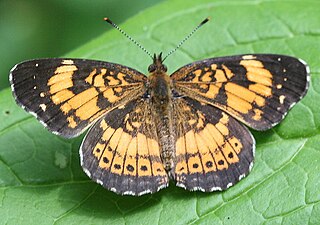
Chlosyne nycteis, the silvery checkerspot, is a species of Nymphalinae butterfly that occurs in North America. It is listed as a species of special concern in Connecticut and Maine, and is believed extirpated in Connecticut, Massachusetts, and New Hampshire.
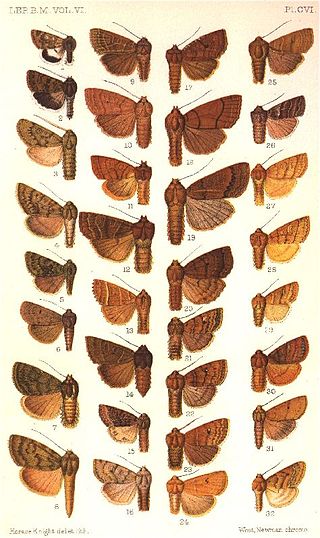
Psectraglaea is a monotypic moth genus of the family Noctuidae described by George Hampson in 1906. Its only species, Psectraglaea carnosa, the pink sallow, described by Augustus Radcliffe Grote in 1877, is native to North America. It is listed as threatened in Connecticut, and as a species of special concern in Massachusetts.

Eumacaria is a monotypic moth genus in the family Geometridae described by Packard in 1873. Its only species, Eumacaria madopata, the brown-bordered geometer moth, was first described by Achille Guenée in 1857. It is found in North America, where it has been recorded from British Columbia, northern Washington, southern Saskatchewan, from Maine to Florida, South Dakota, North Dakota, Nebraska, Wyoming, Idaho, Colorado and New Mexico. The habitat consists of orchards and shrublands. The species is listed as threatened in Connecticut.
Abagrotis nefascia is a moth of the family Noctuidae first described by Smith in 1908. It is found in North America from Alberta and British Columbia down through Massachusetts to California. The species is listed as threatened in the US state of Connecticut.
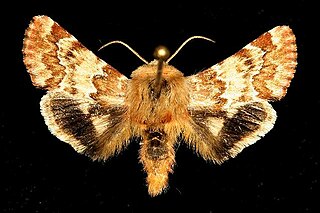
Schinia septentrionalis, the northern flower moth, is a moth of the family Noctuidae. The species was first described by Francis Walker in 1858. It is found in North America from Missouri to Quebec to South Carolina and Louisiana. Records include Colorado, Oklahoma, South Dakota and Texas. It is listed as threatened in the US state of Connecticut.
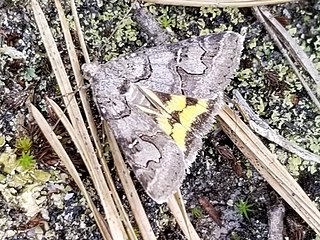
Drasteria graphica, the graphic moth, is a moth of the family Erebidae. The species was first described by Jacob Hübner in 1818. It is found in the United States in coastal dunes from Maine to Florida, west to Mississippi. It is also found along the shores of the Great Lakes in Michigan and Wisconsin. Subspecies D. g. atlantica is listed as threatened in Connecticut.
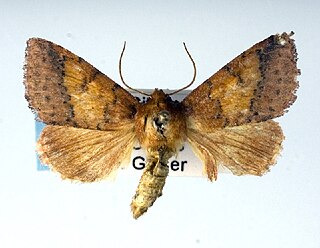
The orange sallow moth or Aureolariaseed borer is a species of moth of the family Noctuidae. It has a scattered distribution from southern Maine and the hills around Boston, Massachusetts, west across southern Ontario to south-western Wisconsin and Missouri, south into Florida and Texas. It is listed as threatened in the US state of Connecticut.

Phaneta pauperana is a moth of the family Tortricidae. It is found in most of central and southern Europe.
Phaneta bimaculata is a species of moth of the family Tortricidae. It is found in China (Jiangxi), Japan and the Russian Far East.
Thaumatopsis edonis is a moth in the family Crambidae. It was described by Augustus Radcliffe Grote in 1880. It is found in North America, where it has been recorded from Florida, Kentucky, Maine, Massachusetts, Mississippi, Missouri, Nebraska, New Jersey, Oklahoma and South Carolina. It is listed as threatened in the US state of Connecticut.

Euchlaena madusaria, the scrub euchlaena moth, is a species of moth of the family Geometridae. It is found in North America, where it has been recorded from British Columbia, east to Nova Scotia, south to Florida, Missouri and Oregon. The habitat consists of dry woodlands. The species is listed as threatened in Connecticut.
Drasteria occulta, the occult drasteria moth, is a moth of the family Erebidae. The species was first described by Henry Edwards in 1881. It is found in North America, where it has been recorded from coastal areas in Maine, New Jersey, Pennsylvania and Texas. It is listed as a species of special concern and believed extirpated in the US state of Connecticut.

Glena cognataria, the blueberry gray moth, is a moth native to North America. It ranges from Florida to Nova Scotia and New Brunswick. Its larvae is hosted on blueberry. The habitat consists of bogs and pine barrens. It is listed as a species of special concern and believed extirpated in the US state of Connecticut.
Chaetaglaea cerata, the waxed sallow, is a species of moth in the family Noctuidae described by John G. Franclemont in 1943. It is found in North America, where it has been recorded from Connecticut, Indiana, Maine, Michigan, Ohio, Ontario, Pennsylvania and Wisconsin.
Papaipema appassionata, the pitcher plant borer, is a species of moth described by Leon F. Harvey in 1876. It is native to North America, where it has been recorded from Florida, Maine, Maryland, Massachusetts, Michigan, Minnesota, New Brunswick, Quebec, Rhode Island, South Carolina and Wisconsin. It is listed as threatened in the US state of Connecticut.
Papaipema circumlucens, the hops-stalk borer moth, is a species of moth native to North America, where it has been recorded from Illinois, Indiana, Michigan, Missouri, New Hampshire, Ohio, Saskatchewan and Wisconsin. The species was described by Smith in 1899. It is listed as a species of special concern and is believed to be extirpated from the US state of Connecticut.
Papaipema sciata, or Culver's root borer moth, is a species of moth found in North America, where it has been recorded from Connecticut, Maine, New York, New Jersey, Iowa, Michigan, Missouri, Minnesota, Illinois, and Wisconsin. It is listed as a species of special concern and believed extirpated in the US state of Connecticut. The species was first described by Henry Bird in 1908.










